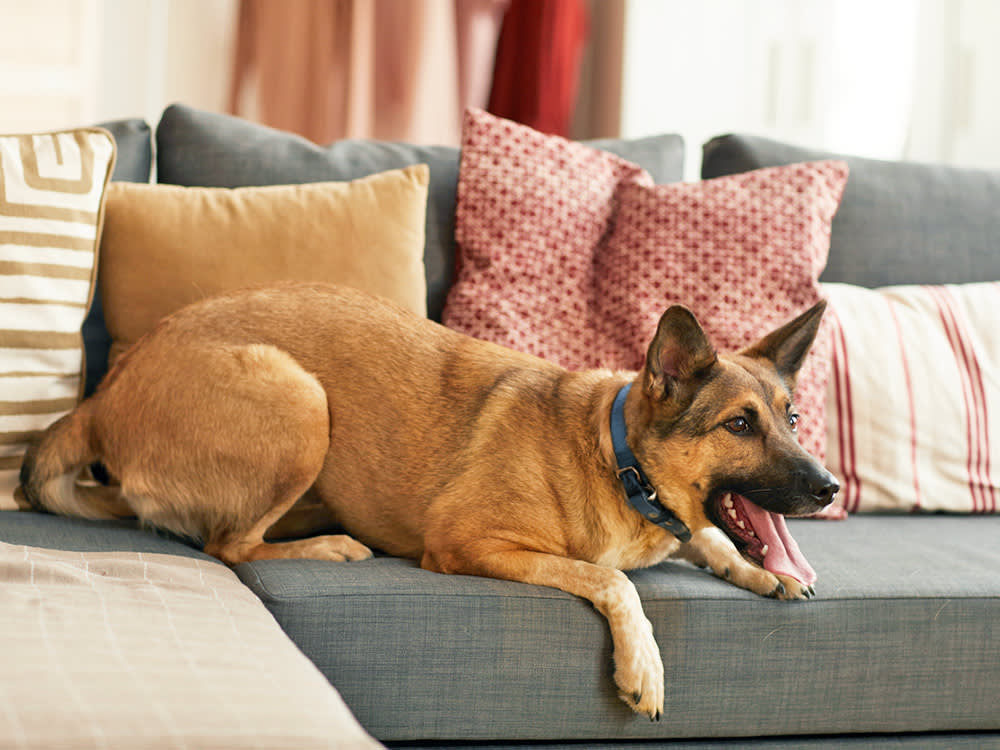How to Stop Your Dog From Barking at the TV
Their show can’t be that good.

Share Article
In This Article:
Why Do Dogs Bark at the TV? How to Stop Dog Barking at TV Effective Training Methods Calming Techniques for Your Dog Is Barking a Sign of a Deeper Issue? Preventing TV Barking in the Future
We’re a kitchen radio kind of family and think it’s fun when our dogs hear another dog barking on the radio and perk up their ears. But when we’re watching a movie on surround-sound? They leave the TV room because it’s too loud. Or maybe they just don’t like the movie.
Other dogs bark, growl, and howl at the TV because the loud noises and moving images are triggering. With a little guidance and training, redirection, and consistent positive reinforcement, you can restore your pup’s calm (and get back to watching TV in peace).
Why do dogs bark at the TV?
Behaviorist Qiai Chong, founder of Pet Coach Singaporeopens in new tab, consults with clients whose dogs bark at inanimate objects, such as televisions and advertisement posters. She recalls a client whose dog barked at ads of grinning men. “This dog had developed a fear association with men, so those images triggered anxiety and barking,” says Chong, who launched Singapore’s first canine behavior rehabilitation facility with her partner, Webster Cheong.

She says the rapid movements, strange lights, and unusual sounds coming from that box on the wall create a stimulating environment that can overwhelm a dog, especially if they’re sensitive. “This mix can prompt barking as a way for your dog to respond to what feels like an unpredictable or threatening situation,” Chong says.
Excitement or stimulation
Dogs watch television and absorb moving images and high-pitched sounds differently than people. They have something called ‘higher flicker fusion frequency,’ meaning they see a series of flickering images on the screen rather than continuous motion. Their ears are more sensitive to loud noises.
“Dogs process movement and sound differently than we do,” Chong says. “High-pitched noises, quick movements, and animal vocalizations can activate instinctive responses, like alerting, chasing or guarding. For some dogs, barking at the TV is about excitement or confusion.”
Territorial behavior
Those strange dogs barking on the TV might be a threat. It’s why some dogs bark in the car when they see a strange dog or person outside. Your dog doesn’t know the TV animals aren’t real, even if they can’t smell them. The sudden movements and sounds mimicking real-life situations triggers their instinct to protect their territory, Chong says.
Confusion
Similar to territorial behavior, your dog barks at the TV when they hear or see something they don’t understand but might find threatening.
Attention-seeking
Sometimes, any attention is good attention. Even if you are let your dog know you aren’t exactly happy with them when they bark at the TV, you’re paying attention to them and reinforcing their impression that barking gets a consistent reaction from you.
Learned association
Dogs who bark incessantly at triggers in daily life (other dogs for example) may generalize that response to similar images or sounds on screen, Chong says.
“In my experience, learned associations often play a major role,” she says. “Through classical conditioning, dogs connect certain images or sounds on TV with things they’ve experienced before, whether it’s other dogs, strangers or loud noises. Because dogs are highly perceptive, even subtle cues can trigger a reaction.”
How to stop dog barking at TV
The first step to stop your dog from barking at the screen without causing stress is understanding the root cause. Once you identify why they’re barking, you can implement actionable solutions. This goes for the TV, trucks or anything that triggers your dog’s barking.
“Is your dog barking for attention, reacting to a negative association, or responding to something specific on the screen, like another dog or a scary-looking person?” Chong asks. She coaches her clients to divide actionable solutions into two groups: management and training.
Limit TV time.
Even if you have to alter your own TV habits, try lowering the volume, dimming the screen or blocking your dog’s view of the TV to discourage barking.
“Limiting TV time is a helpful management tool because sometimes it’s not just how loud or intense the TV is, but how long your dog is exposed to it that matters,” Chong says. “The TV itself is the stimulus here, and reducing duration can prevent your dog from becoming overwhelmed.”
Lock the TV screen.
Similarly, blocking your dog’s view of the screen or simply turning the TV off, helps set them up for success by avoiding exposure to stimuli they can’t yet handle, Chong says.
Desensitize your dog.
Desensitizing means exposing your dog to threats in small increments that don’t elicit big reactions. This could be barking dogs or grinning men. First you’ll need to find something on TV that makes your dog bark. As soon as your dog tolerates the supposed threat’on the TV and stays calm for a short amount of time, give them a treat.
“Gradually, you can increase exposure to the trigger in a controlled way, playing the sounds or images at low intensity and rewarding calm behavior,” Chong says. “This desensitization helps your dog become less sensitive to the triggers, reducing their reactivity over time. The key is to move at your dog’s pace. If they start barking, it means they’re overwhelmed.
Take a step back, adjust the environment, and focus on making them feel safe. This approach encourages lasting behavior change without stress.”
Interrupt the barking.
If you don’t have the right environment to desensitize your dog, interrupt their barking by removing them from the TV room to a calm, quiet location.
Provide distraction.
Like many unwanted behaviors, barking at the TV can be addressed with distractions. When your dog starts barking at the TV, remove them to a quieter spot and give them an engaging toy like a Kong stuffed with peanut butter.
Effective training methods
Training your dog or puppy in small daily increments is the most effective way to reinforce skills like siting, staying and heeling. The same strategy can stop undesirable behavior such as barking at the TV. Just don’t be tempted to use an anti-bark device.
Use positive reinforcement
When your dog sits in front of the screen for a short while without barking and you reward them, you’re providing positive reinforcement for not barking. With practice, patience and consistency, your dog will learn they get rewarded for not barking.
“Once your dog is calm and comfortable, you can gradually expose them to the TV at a level they can handle,” Chong says. “That might mean lowering the volume or avoiding scenes with triggers, like dogs running on screen if your dog is fearful of other dogs. This step-by-step approach helps your dog build confidence and reduces their need to bark.”
Redirect their attention.
Instead of waiting for barking to happen, work on redirecting your dog’s attention before they start barking. “Teach a cue like ‘look’ or ‘sit,’ and when your dog responds with calm behavior instead of barking, reward them generously. This helps your dog learn a positive alternative and gradually breaks the barking habit over time,” Chong says.
Use specific cues.
The words “look,” “sit,” and “no bark” are verbal cues that give your dog boundaries and direction, all of which can be comforting when they’re triggered by the TV. My dogs respond to “leave it” as a catch-all cue to stop barking at a knock on the door or stop licking the floor in search of crumbs.
Calming techniques for your dog
Calming techniques used in conjunction with redirection and desensitization training are effective. But they are not a solution in and of themselves.
“The priority is to keep your dog below their threshold, that’s how you ensure they stay calm,” Chong says. “This means managing the environment carefully to avoid overwhelming them.”
Use interactive toys or treats.
Interactive toys or treats can be used to redirect your dog from the TV before they start barking or after they’ve been in front of the screen for a while without barking.
Play white noise to reduce external stimulation.
If the TV is making your dog agitated, redirect them to a quieter part of the house and play white noise or calming music.
Create a quiet, cozy spot.
If you sense the TV is making your dog anxious, create a safe space where they can retreat when the volume is loud. Reward them for going to their quiet spot with a treat or a toy.
Use home remedies
• Lavender scent: Lavender essential oil is a time-tested remedy for calming people and pets. Dilute it and mist it in your dog’s crate or on their bed (talk to your vet first before using any essential oil around your dog).
• Weighted blankets: People have long enjoyed the calming sensation of being under heavy blankets. The same is true for dogs, whose concerned parents are the source of marketing campaigns for canine weighted blankets.
Is barking at the TV a sign of a deeper issue?
Some dogs enjoy watching TV and will bark at animals they see and hear. If you allow the barking to continue, prolonged screen time could lead to a deeper issue. “For some dogs, it’s demand barking. They’ve learned that barking gets your attention,” Chong says. “For others, it may reflect anxiety or the generalization of negative associations and triggers from real life.”
Anxiety or fear
Dogs may be scared of images on the screen that resemble images they fear in real life. If they’re reactive to specific triggers like other dogs, men, or loud voices, they’ll respond by barking at the perceived threat.
Health-related issues
Barking at the TV can become a health issue if your dog gets so agitated they become aggressive. Consult with a vet or behaviorist if the barking is excessive enough to create health issues.
Behavioral disorders
Demand barking is considered a behavioral disorder, as is barking connected to a negative association with sounds and images on the TV.
Preventing TV barking in the future
There are many reasons why dogs watch TV, but it can be overstimulating for some, who — rather than leave the room — start barking. In that case, limiting access to the TV is the best strategy for your pup’s long-term health. That’s true for all of us. The same goes for routine, socializing, and exercise.
“Routine, socialization, and mental or physical stimulation are great for your dog’s overall wellbeing, but they aren’t direct solutions for barking at the TV if the root cause is a negative association or demand barking,” Chong says.
Establishing routine
If you routinely watch TV in the evening and redirect your dog to discourage barking, your dog may come to associate your routine as a cue for them to retreat to their bed, maybe with a treat or a toy you’ve given them.
Socialization
A well-socialized dog who’s confident in a variety of environments and situations may be less inclined to bark at the TV.
Proper mental and physical stimulation
Exercise and mental activity should be part of every dog’s routine and will go a long way towards helping your dog stay calm at home.
References
Overall, Karen L. “Understanding How Dogs Learn: Importance in Training and Behavior Modificationopens in new tab,” World Small Animal Veterinary Association, 2006.
Shih, Hao-Yu, et al. “Perceptions of Taiwanese Owners and Behaviour Veterinarians on Behavioural Problems in Dogs and Preferred Training Approaches.” Applied Animal Behaviour Science, vol. 266, 1 Sept. 2023, pp. 106026–106026, https://doi.org/10.1016/j.applanim.2023.106026.
Sinnott, Richard. Predicting and Avoiding Dog Barking Behaviour through Deep Learning. 29 Jan. 2024, https://doi.org/10.1145/3641142.3641176opens in new tab.
Zurlinden, Samantha, et al. “Impact of Classical Counterconditioning (Quiet Kennel Exercise) on Barking in Kenneled Dogs—a Pilot Study.” Animals, vol. 12, no. 2, 11 Jan. 2022, p. 171, https://doi.org/10.3390/ani12020171opens in new tab.

Catherine Fahy Green
Catherine Fahy Green is a journalist turned copy and content writer. As a pets writer, she focuses on and is fascinated by animal body language because there's so much to learn from and about animals by spending time in their presence and observing their physical cues.
Her work as a PR specialist appears in national trade media as press releases and stories about exciting new products people should try. She lives with her family in Western Massachusetts, where she listens closely to the stories her two dogs, flock of chickens, and four horses tell her. She spends her weekends at horse shows with her daughter.
Related articles
Why Do Dogs Chase Trucks?
Why do some dogs seem to lose their minds when a truck goes by?
![Dog barking on the sidewalk in front of a pink wall]()
How to Fix Your Dog’s Non-Stop Barking
You can live in a quiet house again.
![English bulldog looks through a snow-covered gate]()
Is Your Dog All Bark and No Bite?
A viral video gives new meaning to being on the fence.
Why Does Your Dog Howl at Night?
It’s funny at first… until it ruins your sleep.
![Cute black dog pulling on his leash outside on the sidewalk.]()
How to Stop a Dog From Chasing Cars
A pickup truck is not a squirrel, buddy.
![Dog Barking In Nature Next To Its Owner.]()
Getting Ads for Anti-Barking Devices? Here’s Why You Shouldn’t Buy One
Two trainers advocate against using these devices—here’s why.







